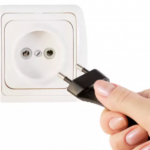Laminate flooring is a floating type. It is not attached to the base, its integrity is ensured by the adhesion of individual elements to each other.
Under the laminate, a substrate is necessarily laid, which serves as a shock absorber, a sound insulator that impedes the transmission of noise that occurs when walking on the floor. In addition, in its functions: to protect the laminate from particles of debris, sand formed on the underlying surface; prevent the penetration of residual moisture from the floor elements.

The answer to the question posed in the title may sound like this: under the laminate you can not lay a substrate that does not meet the requirements of manufacturers of this type of floor. It is better to abandon the use for this linoleum, carpet.
According to experts, extruded polystyrene in rolls should also not be laid under the laminate, if there is a choice with the available money. Although this type of substrate, in general, is in demand, probably because of the advertising of the sellers themselves, most of all.

According to experts, extruded polystyrene has no positive properties, except for the price, which would distinguish the material from analogues. It is difficult to lay because of the constant coiling of the roll, the fragility of the canvas. The latter leads to broken edges, which can only be restored by gluing with tape. The view will not be very good.
Such a substrate has a small thickness, which is equal to 2 millimeters. After some time of exploitation of the floor, it, in most cases, decreases and the material becomes completely thin. He also does not have fire safety advantages, which many sellers try to convince buyers of.

The best substrate for a laminate is cork. It is environmentally friendly, since the gluing of cork bark crumbs is done by suberin - a natural substance. It is produced with a thickness of 2.3 mm, but more often the first is on sale.

The cork substrate is the toughest among analogues, therefore it practically does not allow the laminate to sag and collapse at the joints. Although this applies more to well-aligned bases - it is not able to compensate for large swings on it.

Among the best substrates under the laminate is coniferous. But it is sheet and takes longer than roll. Requires, for reliability, gluing joints with adhesive tape. Under it, you need to make another lining - a vapor barrier film.

A good option is a foam pad made of gas-filled polyethylene. It is more suitable for an inexpensive laminate. Its advantages are fast flooring, low price. Among the shortcomings is the punching of the substrate with time to a minimum thickness, which can cause a creak of the floor when moving on it. Compressed to a minimum, the substrate will not protect the laminate from unevenness of the base, and this often leads to breakage of locks.

Among the recommended by the masters of substrates: branded Quick Step, Tuplex and Profitex.

-
 What is a heating meter
What is a heating meter
-
 Where you should not have an electrical panel in a private house
Where you should not have an electrical panel in a private house
-
 Why does the socket not let in the plug of the appliance?
Why does the socket not let in the plug of the appliance?
-
 What materials are not suitable for effective sound insulation of an apartment
What materials are not suitable for effective sound insulation of an apartment
-
 Errors in choosing heating boilers
Errors in choosing heating boilers
-
 How to dock a carpet so that it does not go in waves
How to dock a carpet so that it does not go in waves
-
 Where is the feed at the radiator with bottom connection
Where is the feed at the radiator with bottom connection
-
 What to do if wallpaper glue dries too fast
What to do if wallpaper glue dries too fast
-
 How to make a chic euro odnushka or a spacious studio out of 2 rooms in Khrushchev
How to make a chic euro odnushka or a spacious studio out of 2 rooms in Khrushchev
-
 Why is it more profitable to build a house on 2 floors than with an attic
Why is it more profitable to build a house on 2 floors than with an attic
-
 For what devices people did not conduct wiring, and then very much regretted
For what devices people did not conduct wiring, and then very much regretted
-
 New bill: how much do you have to pay for electricity
New bill: how much do you have to pay for electricity
New publications are published daily on our channel in Yandex. Zen
Go to Yandex. Zen


